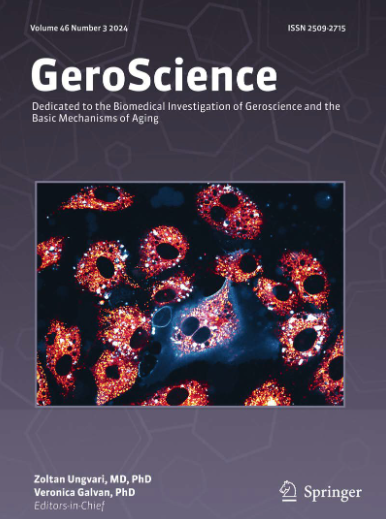衰老相关基因特征预测肺癌患者的生存:一项多队列分析
IF 5.4
2区 医学
Q1 GERIATRICS & GERONTOLOGY
引用次数: 0
摘要
肺癌是世界范围内癌症相关死亡的主要原因,主要在老年人中诊断,强调有必要探索影响疾病进展和预后的衰老相关生物学机制。细胞衰老是衰老的标志,在癌症中发挥双重作用,通过影响肿瘤生长、调节肿瘤微环境、衰老相关分泌表型(SASP)和对治疗的反应,促进肿瘤抑制和肿瘤促进。在这项研究中,我们使用三个独立的基因标记,包括SenMayo基因集和两个额外的筛选列表,评估了衰老相关基因表达在肺癌中的预后意义。使用Cox回归、Kaplan-Meier生存分析和多变量模型分析来自公开数据集的转录组学和临床数据。所有三种衰老特征都与总生存期显著相关,其中SenMayo特征显示出最稳健和一致的预后能力。值得注意的是,在整个肺癌队列和肺腺癌中,衰老相关基因的高表达与生存率的提高有关,而在鳞状细胞癌中则出现了更为异质性的模式。尽管不同基因组的风险比不同,但它们与临床结果的广泛一致的相关性突出了肺癌中衰老的生物学相关性和环境依赖性。这些发现表明,衰老相关基因表达可能作为一种有价值的预后生物标志物,并为肿瘤行为提供机制见解。我们的研究结果促进了老年肿瘤学研究的发展,并强调了癌症中衰老相关过程的肿瘤特异性探索的必要性。本文章由计算机程序翻译,如有差异,请以英文原文为准。
Senescence-associated gene signatures predict survival in lung cancer: a multi-cohort analysis.
Lung cancer is a leading cause of cancer-related mortality worldwide and is predominantly diagnosed in older adults, underscoring the need to explore aging-related biological mechanisms that influence disease progression and prognosis. Cellular senescence, a hallmark of aging, plays a dual role in cancer by contributing to both tumor suppression and tumor promotion through its influence on tumor growth, modulation of the tumor microenvironment, the senescence-associated secretory phenotype (SASP), and response to therapy. In this study, we evaluated the prognostic significance of senescence-related gene expression in lung cancer using three independent gene signatures, including the SenMayo gene set and two additional curated lists. Transcriptomic and clinical data from publicly available datasets were analyzed using Cox regression, Kaplan-Meier survival analysis, and multivariate modeling. All three senescence signatures were significantly associated with overall survival, with the SenMayo signature showing the most robust and consistent prognostic power. Notably, higher expression of senescence-associated genes was associated with improved survival in the overall lung cancer cohort and in lung adenocarcinoma, while a more heterogeneous pattern emerged in squamous cell carcinoma. Although hazard ratios varied among the gene sets, their broadly concordant associations with clinical outcomes highlight the biological relevance and context dependence of senescence in lung cancer. These findings suggest that senescence-associated gene expression may serve as a valuable prognostic biomarker and offer mechanistic insights into tumor behavior. Our results contribute to the growing body of gero-oncology research and emphasize the need for tumor-specific exploration of aging-related processes in cancer.
求助全文
通过发布文献求助,成功后即可免费获取论文全文。
去求助
来源期刊

GeroScience
Medicine-Complementary and Alternative Medicine
CiteScore
10.50
自引率
5.40%
发文量
182
期刊介绍:
GeroScience is a bi-monthly, international, peer-reviewed journal that publishes articles related to research in the biology of aging and research on biomedical applications that impact aging. The scope of articles to be considered include evolutionary biology, biophysics, genetics, genomics, proteomics, molecular biology, cell biology, biochemistry, endocrinology, immunology, physiology, pharmacology, neuroscience, and psychology.
 求助内容:
求助内容: 应助结果提醒方式:
应助结果提醒方式:


